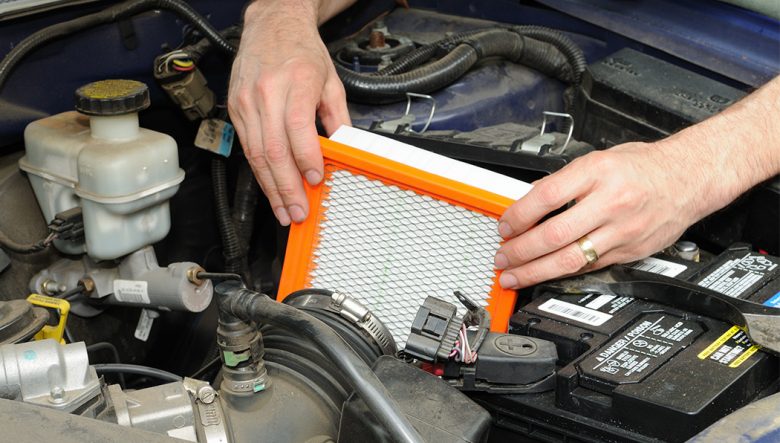


The air filter on most modern combustion engines is located inside the air intake housing, which is installed on the top of the engine. It is attached to the fuel injection system (or a turbocharger) and designed to efficiently transport air into the fuel system to be mixed before it enters the combustion chamber. The main duty of the air filter is to remove dirt particles, dust, debris, and other impurities before the air mixes with the fuel to become a vapor. When the air filter becomes clogged with debris, it can cause the engine’s fuel efficiency and power output to decrease. If oil is found inside the air filter, it can also significantly impact the engine’s performance.
It’s generally a good idea to have a qualified technician perform an annual service, where the air filter is changed and do an inspection on your car to see if there is engine oil inside your air filter or air intake housing. If the underlying cause is correctly identified, you may be able to avoid expensive, significant repairs.
UNDERSTAND HOW THE AIR FILTER WORKS.
The air filter works effectively in ensuring the engine “breathes” with ease. The air filter traps the built-up contaminant and debris that stands as potential threats to the engine. Then, during your routine checks, you clean the air cleaner and remove the accumulated dirt.
5 Signs That You Need to Change Your Car Air Filter
Air filter looks dirty – a new air filter will be white or an off-white colour.
Check engine light turns on.
Loss of power.
Black, sooty smoke leaving the exhaust pipe.
Smell of gas when the engine starts.
COMMON CAUSES OF GETTING OIL IN THE AIR FILTER
1. Clogged Positive Crankcase Ventilation (PCV) Valve
The positive crankcase ventilation (PCV) valve was introduced as one of the first emissions controls, and redirects blow-by (the burned gases, after combustion), back into the air intake instead of letting it pollute the environment.
A PCV valve needs to be replaced occasionally, just like an oil filter. The positive pressure in the crankcase needs a place to go.
If a PCV valve becomes clogged, blow-by may end up slipping through seals or any other tiny gaps in the engine it can find. The valve could also be stuck open allowing more oil to enter the intake than intended.

What’s the solution?
If it is determined that a clogged PCV valve is the source of engine oil inside your air filter or air intake system, it should be replaced, the air intake should be cleaned, and a new air filter should be installed.
2. Worn Piston Rings
Piston rings provide a seal between the cylinder wall and the piston to maximize the force applied by the combustion of the air-fuel mixture in the combustion chamber. The stronger the force, the more power your car will have.
Over time, piston rings can become worn due to high mileage, improper maintenance, poor engine design, or running the engine hard before it has reached operating temperature. As a car ages and piston rings wear, you might see horsepower numbers gradually decrease and blow-by gradually increase as the quality of this seal deteriorates.
When the volume of the blow-by starts to increase, you may notice more oil in the air filter housing, possibly extending all the way to the air filter itself.
To diagnose worn piston rings, you can do a compression test on each cylinder to verify the pressure. Cylinder pressures should be relatively equal across all cylinders, and the factory manual will include the manufacturer’s specification for what the acceptable range for cylinder pressures should be. To replace worn piston rings, an engine rebuild is required.


What’s the solution?
If you notice engine oil in the air filter or intake housing, a qualified technician might recommend a compression test. This is where the technician will install a compression gauge on each individual spark plug hole to check the compression of each cylinder. If the compression is lower than it should be, worn piston rings are usually the culprit. Unfortunately, this repair is not as easy as replacing a PCV valve.
3. Clogged Oil Channels
When oil change intervals are neglected or skipped, the old oil will thicken and form a sludge. This engine sludge can clog oil channels which exist to keep the engine well lubricated and to keep the oil flowing through the engine as designed.
When these channels are blocked, oil and sludge may accumulate in areas of the engine it wasn’t meant to go, including the intake. This may reduce horsepower and fuel economy, and could cause total engine failure if left unchecked for a long period of time.

What’s the solution?
In this instance, sometimes changing the engine oil, filter, PCV valve, and replacing the dirty air filter is good enough. However, if clogged oil galleys are discovered, it is usually recommended to flush the engine oil and replace the oil filter at least twice within the first 1 500 kilometres to ensure the engine’s oil galleys are clear of debris.
Though finding oil in your air filter will not cause major issues in the immediate moment, it can however lead to severe engine issues later down the line and might also cause your emissions to worsen. Visit on of our VAG Spec Centre branches and get it fixed as soon as when first observed is a good idea.

